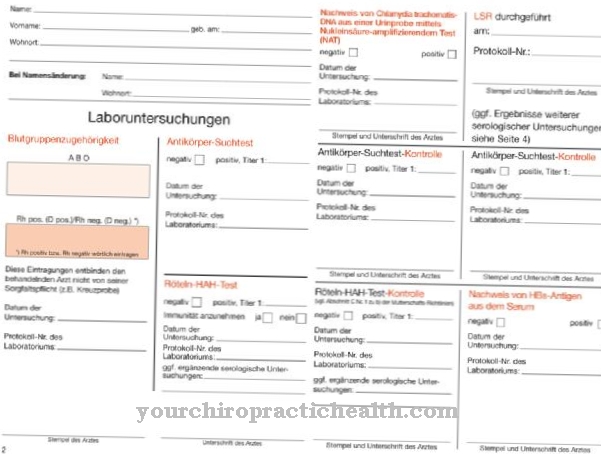A pacemaker enables patients to actively shape their lives again. After a wound healing phase and a period of getting used to it, most patients no longer notice it at all. People with a pacemaker can work and play sports. If the device is implanted and properly adjusted, you can lead a completely normal everyday life. The individual design of life includes leisure activities, which in addition to the pursuit of hobbies also include traveling Pacemaker include.
Vacation despite a sick heart
For dMost people who have a pacemaker have unlimited travel. A limited one Fitness to travel with a pacemaker is not due to the implanted device, but to a serious underlying cardiac disease. Typically, a patient is able to travel three weeks after the device is implanted.
As a guideline for the ability to travel is a physical performance, at which 75 watts are reached. Patients with pacemakers can sunbathe on vacation. The climate and the cold or hot temperatures at the holiday destination as well as the UV radiation have no influence on the unit of the device. However, sunburn can cause irritation in the area of the aggregate pocket.
Patients with pacemakers have to accept restrictions on diving vacations. In deeper waters, the pressure increases underwater. This increased pressure is transmitted from the tissue inside the body to the pacemaker. At depths of more than five meters, tissue fluids can be pressed into the pacemaker and damage the electronics.
The last aggregate inspection should not be more than half a year ago before the start of the vacation trip. If a longer trip is planned, the check-up should be brought forward to bring the probe function and battery level to the optimal value and to read out the error memory so that the pacemaker can be set correctly.
The manufacturer of the units can provide information on whether the pacemaker can be checked in the holiday country. The attending physician has addresses of cardiologists and hospitals in the planned travel destination. These addresses are important in order to receive competent medical care in the event of complaints that can occur despite a well-adjusted device.
Possible complaints that require the help of a specialist include a slow heartbeat and muscle twitching around the device. If the area of the body around the pacemaker is red or causing pain, treatment must be given at the resort. This also applies if the outlines of the device can be seen or felt under the skin from the outside.
If other illnesses have to be treated at the holiday destination, medical staff and the treating doctors must always be informed immediately about the pacemaker. In most cases, medical examinations and treatments have no influence on the functionality of the pacemaker. However, special precautions are necessary with some medical procedures. These include short wave therapy and therapeutic ultrasound.
Traveling by plane
Long car journeys are more stressful for the heart than a short flight. On long-haul flights, the risk of thrombosis increases because the air in the aircraft is dry and passengers sit for a long time. As a preventive measure, compression stockings should be worn during the flight. The feet must also be moved regularly while sitting. If the flight lasts longer than five hours, an anticoagulant medication that is injected under the skin before departure can be useful.
Out and about by car and train
Regular breaks are important to prevent embolism on long journeys by train or car. The pacemaker patient has to get up regularly and walk around a bit. The pacemaker does not affect the fitness to drive. It is always mandatory to wear seat belts. An exemption from the general seat belt requirement is not possible.
In the event of an accident, there is no risk of the seat belt damaging the unit. It is not advisable to keep your torso close to a running engine when repairing your car. The electrical ignition can disrupt the function of the pacemaker.
What to do at the security check
Metal parts are processed in the pacemaker, which can trigger an alarm in a security gate. However, a security lock cannot damage the pacemaker. Prior to the security check, security personnel should be informed of the presence of the pacemaker. A check by hand is gentler, as the metal detectors that are used at the airport can influence the unit.
The influence only takes place as long as the metal detector is held over the area of the pacemaker. A manual security check is usually possible by showing the patient ID. In addition, unnecessary triggering of an alarm by the security system is prevented.
If a manual safety investigation is rejected, the security personnel should carry out the check quickly and avoid holding the metal detector directly over the pacemaker.
You can find your medication here
➔ Medicines for cardiac arrhythmiasIt works with the right preparation
With appropriate preparation, patients with a pacemaker can travel without any problems. The check-ups must have been carried out regularly. The device should be set correctly and the device pass must be carried in hand luggage. Addresses of cardiologists and hospitals who are familiar with the treatment of pacemaker patients will be requested prior to departure.
During the journey to the holiday destination, make sure you have enough exercise and fluid intake to prevent embolism. At the destination, medical help should be sought immediately in the event of complaints that occur around the body of the device and if the heart rate is weak.
The cardiac pacemaker should be pointed out at security checkpoints and personal checks at airports and a manual security check should be selected if possible. Every time you visit a doctor that is not related to the pacemaker, you must always be informed about the pacemaker.

























.jpg)


